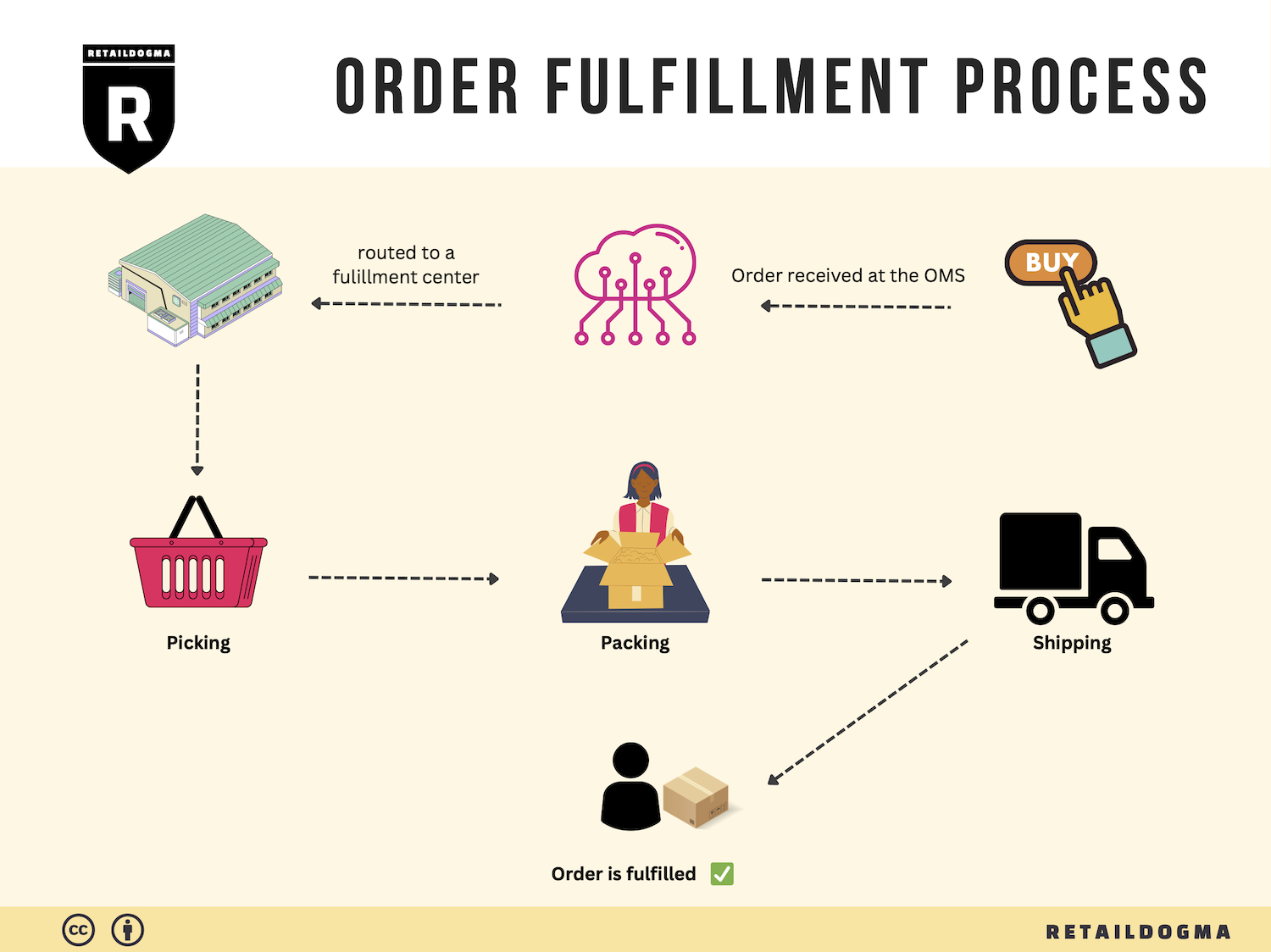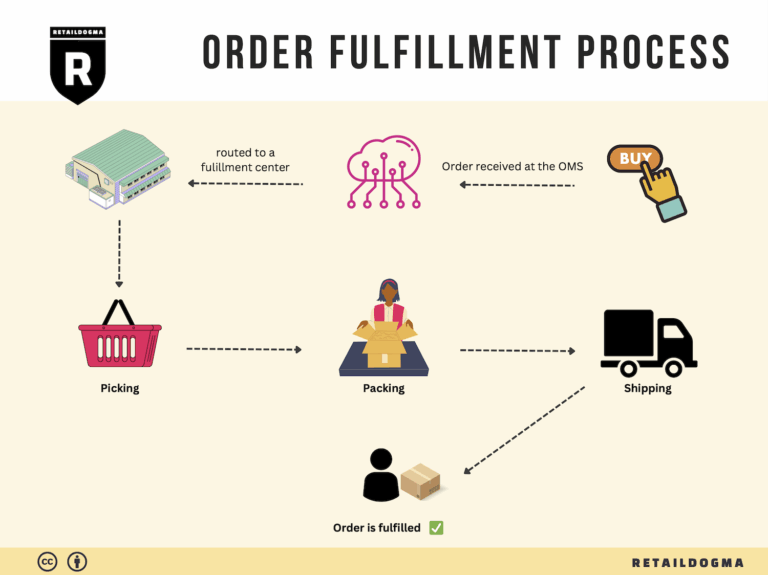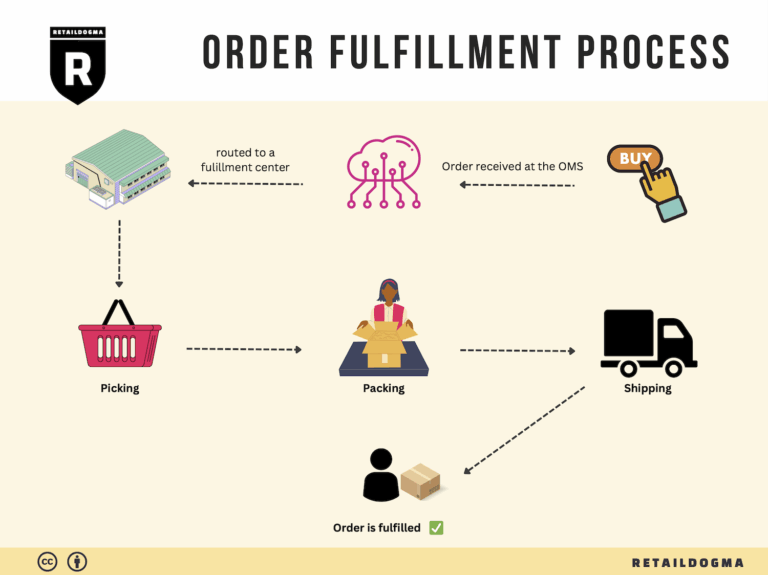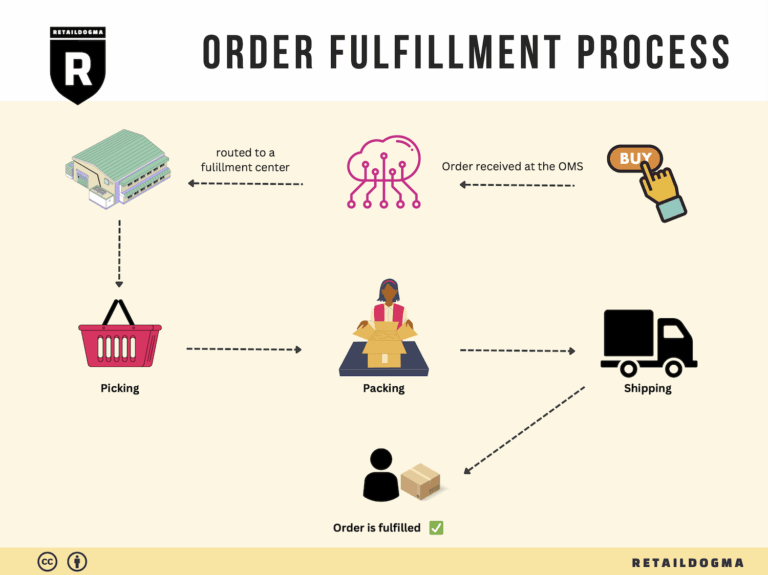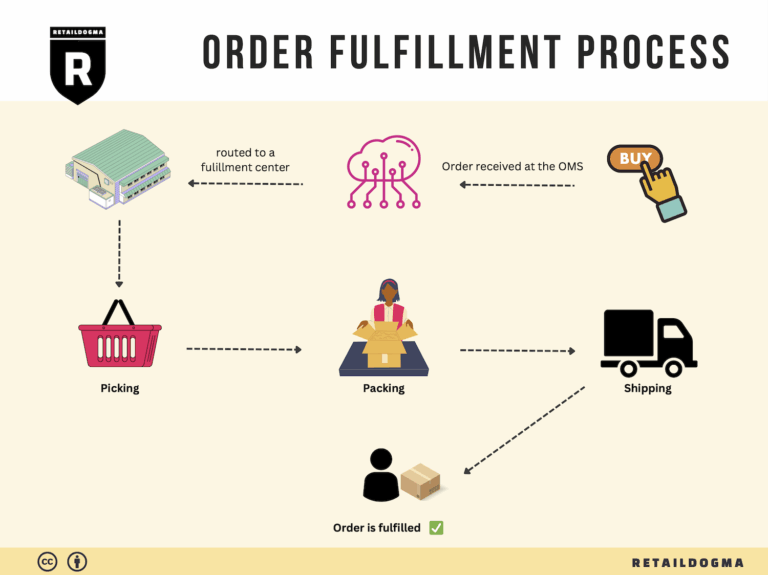Ecommerce Fulfillment Services: The Ultimate Guide (2025)
What is E-commerce Fulfillment? An Introduction for Growing Businesses
Navigating the Challenges of E-commerce Fulfillment
As your online business begins to grow, you may find yourself grappling with the complexities of packing and shipping orders. The excitement of increasing sales can quickly turn into stress as you face the daunting tasks of inventory management, order processing, and shipping logistics. This overwhelm is a common pain point for many entrepreneurs; the fulfillment process can feel like an insurmountable challenge, pulling you away from what truly matters—growing your brand and connecting with your customers.
At its core, fulfillment refers to the entire process of getting a product into the hands of a customer. This includes receiving orders, picking and packing items, and managing the shipping process. As your order volume rises, the intricacies of fulfillment can become increasingly complicated, and many business owners reach a tipping point where they must consider outsourcing these tasks.
This guide aims to demystify the world of e-commerce fulfillment, providing you with the insights needed to make informed decisions for your growing business. We will explore various fulfillment models, including Third-Party Logistics (3PL) and Fulfillment by Amazon (FBA), helping you understand the pros and cons of each. By examining core services provided by fulfillment partners—such as inventory storage, order picking, packing, shipping, and returns management—you’ll gain a comprehensive understanding of what to expect from a fulfillment service.
Choosing the right fulfillment partner is a critical decision that can significantly impact your operational efficiency and customer satisfaction. We will outline key factors to consider when selecting a partner, such as their technological capabilities, geographic reach, and experience in your industry. Additionally, we will delve into the costs associated with outsourcing fulfillment, providing you with a clear picture of potential pricing structures and how to budget effectively.
Ultimately, this guide is designed to empower you to make smart, strategic decisions about your logistics. By understanding the fulfillment landscape and knowing your options, you can free yourself from the logistical burdens that come with growth and focus on scaling your business effectively. Whether you’re just starting to explore fulfillment outsourcing or are ready to make the leap, the insights provided here will serve as a valuable resource on your journey to success.
What You’ll Learn In This Guide
- What is E-commerce Fulfillment? An Introduction for Growing Businesses
- The Order Fulfillment Process: From ‘Buy’ Button to Customer’s Door
- Comparing Fulfillment Models: In-House vs. 3PL vs. Dropshipping
- A Deep Dive into Amazon FBA: Pros, Cons, and Who It’s For
- Core Services Offered by Fulfillment Centers
- How to Choose a Fulfillment Partner: A 6-Point Checklist
- Understanding Fulfillment Pricing: A Breakdown of Common Fees
- Frequently Asked Questions (FAQs) about Fulfillment
- Conclusion: Is Outsourcing Fulfillment the Right Move for Your Business?
- Important Disclaimer
The Order Fulfillment Process: From ‘Buy’ Button to Customer’s Door
1. Receiving Inventory
The first step in the order fulfillment process is receiving inventory. When new stock arrives at the fulfillment center, it must be carefully checked and recorded. This process typically involves verifying the shipment against the purchase order to ensure that the correct items and quantities have been delivered. Each product is assigned a unique identifier known as a Stock Keeping Unit (SKU), which is crucial for tracking inventory throughout the fulfillment process.
Importance: Proper inventory receiving is critical for maintaining accurate stock levels and preventing discrepancies that can lead to stockouts or overstocking. An efficient receiving process also sets the stage for streamlined operations in subsequent steps.
Key Term: SKU (Stock Keeping Unit) – A unique identifier for each distinct product and service that can be purchased, essential for inventory management.
2. Warehouse Storage
Once the inventory is received, the next step is warehouse storage. This involves organizing and storing the products in designated areas within the fulfillment center. Efficient storage strategies, such as using shelving units or bins, are employed to maximize space and facilitate easy access to items.
Importance: Effective warehouse storage is vital for reducing retrieval times during the picking process. It ensures that products are stored in a logical order, making it easier for staff to locate items quickly, which is crucial during peak seasons when order volume increases.
Key Term: Bin Location – A specific area within the warehouse designated for storing particular items, which helps streamline the picking process.
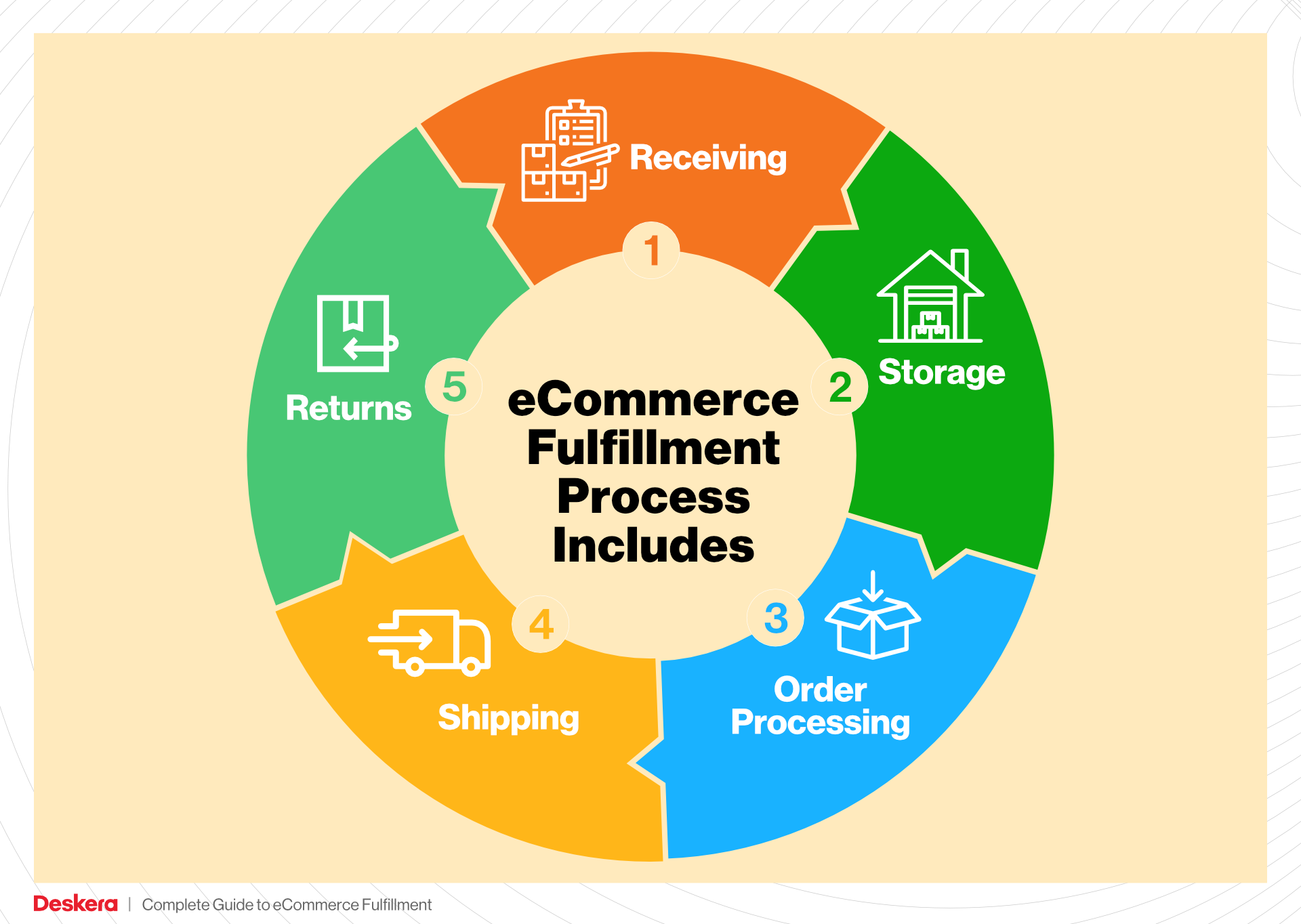
3. Order Picking
Order picking is the process of retrieving items from their storage locations to fulfill customer orders. When a customer places an order, a pick list is generated, detailing the items and quantities needed. Warehouse staff then use this list to gather the required products.
Importance: Order picking is a critical step in the fulfillment process, as it directly impacts order accuracy and delivery speed. A well-organized picking system can significantly enhance efficiency and reduce the chances of errors, such as picking the wrong item or quantity.
Key Term: Pick List – A document or digital tool that outlines the items and quantities to be picked for fulfilling customer orders, guiding staff through the retrieval process.
4. Order Packing
Once the items have been picked, the next step is order packing. This involves carefully packaging the products to ensure they arrive at the customer’s door in perfect condition. Packing materials, such as boxes, bubble wrap, and packing peanuts, are selected based on the nature of the items being shipped.
Importance: Proper packing is essential not only for protecting the items during transit but also for presenting a professional image to the customer. Well-packaged orders can enhance customer satisfaction and reduce the likelihood of returns due to damage.
Key Term: Packing Slip – A document included in the package that lists the items in the order, often used for verification by the customer upon receipt.
5. Shipping & Delivery
The final step in the order fulfillment process is shipping and delivery. After packing, orders are scheduled for pickup by shipping carriers. The fulfillment center must choose the most efficient shipping method based on cost, speed, and customer preferences. Once shipped, tracking information is provided to the customer to monitor their order’s progress.
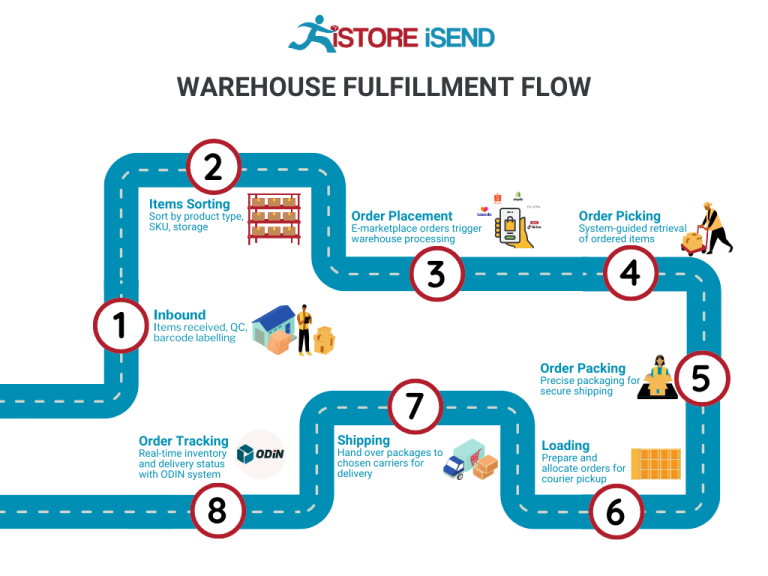
Importance: Timely and accurate shipping is crucial for customer satisfaction and loyalty. With the rise of e-commerce giants, customers increasingly expect fast and reliable shipping options. Efficient shipping processes can also lead to cost savings for the business, especially when leveraging carrier relationships for discounted rates.
Key Term: Tracking Number – A unique identifier assigned to a shipment that allows customers to track its progress and estimated delivery date through the carrier’s system.
By understanding and optimizing each step in the order fulfillment process, e-commerce businesses can enhance operational efficiency, meet customer expectations, and ultimately drive sales growth. Outsourcing fulfillment to a trusted third-party logistics provider can streamline these processes, allowing businesses to focus on core activities that drive value.
Comparing Fulfillment Models: In-House vs. 3PL vs. Dropshipping
Fulfillment Models Comparison
| Model | Who Handles Inventory | Best For (Business Stage) | Key Advantage | Key Disadvantage |
|---|---|---|---|---|
| In-House Fulfillment | Business Owner/Staff | Startups to Small Businesses | Complete control over inventory and fulfillment processes | High operational costs and resource commitment |
| Third-Party Logistics (3PL) | 3PL Provider | Growing to Mid-Sized Businesses | Scalability and access to advanced logistics technology | Less control over the fulfillment process |
| Dropshipping | Supplier | Startups to Small Businesses | Low upfront costs and no inventory risk | Lower profit margins and potential supplier issues |
In-House Fulfillment
In-house fulfillment is the process where e-commerce businesses manage their own storage, packing, and shipping of products. This model is often favored by startups and small businesses that are just beginning to establish their brand and customer base. The key advantage of in-house fulfillment is the complete control it offers over inventory and fulfillment processes. Business owners can ensure quality control, customize packaging, and maintain direct oversight of the order fulfillment process. However, this model comes with significant disadvantages. Managing fulfillment in-house requires substantial operational resources, including warehouse space, staffing, and equipment, which can lead to high fixed costs. As order volumes grow, the complexity of operations increases, making it challenging for business owners to maintain focus on core activities like marketing and product development. Ultimately, while in-house fulfillment can work in the early stages, it may hinder scalability and efficiency as the business grows.
Third-Party Logistics (3PL)
Third-party logistics (3PL) is a fulfillment model where businesses outsource their warehousing and fulfillment operations to a specialized provider. This model is particularly suitable for growing and mid-sized businesses that experience fluctuating order volumes and need to scale quickly. The key advantage of working with a 3PL is scalability and access to advanced logistics technology. 3PL providers have established networks of fulfillment centers, allowing businesses to ship products more efficiently and reduce shipping times. They also offer services such as inventory management, returns processing, and tracking, freeing up valuable time and resources for business owners. However, a significant downside is the loss of direct control over the fulfillment process. Businesses must rely on the 3PL’s performance and capabilities, which can vary widely among providers. Additionally, while outsourcing can streamline operations, it also introduces the potential for miscommunication and delays if the partnership is not managed effectively. Thus, choosing a reliable 3PL partner is crucial to ensure a seamless fulfillment experience.
Dropshipping
Dropshipping is a fulfillment model where the business does not hold inventory but instead relies on suppliers to ship products directly to customers. This model is particularly attractive to startups and small businesses with limited upfront capital, as it eliminates the need for inventory investment and storage space. The primary advantage of dropshipping is the low operational risk; businesses only pay for products after they are sold, which significantly reduces financial exposure. Additionally, dropshipping allows for a wide product range without the burden of inventory management. However, it comes with notable drawbacks. The profit margins in dropshipping can be lower compared to traditional fulfillment models due to reliance on suppliers and their pricing structures. Furthermore, businesses often have less control over product quality, shipping times, and customer service, which can impact the overall customer experience. Issues such as stock shortages or supplier errors can lead to delays and dissatisfaction, making it essential for dropshippers to establish strong relationships with reliable suppliers.
In conclusion, selecting the right fulfillment model is critical for e-commerce business owners aiming to scale effectively. Each model—In-House Fulfillment, 3PL, and Dropshipping—offers distinct advantages and disadvantages that must be carefully weighed against the business’s current stage, operational capacity, and growth ambitions. Understanding these nuances will enable entrepreneurs to make informed decisions that align with their overall business strategy.
A Deep Dive into Amazon FBA: Pros, Cons, and Who It’s For
Understanding Fulfillment by Amazon (FBA)
Fulfillment by Amazon (FBA) is a service offered by Amazon that allows sellers to store their products in Amazon’s fulfillment centers. Amazon then takes care of storage, packaging, and shipping of the products directly to customers. This service not only streamlines logistics for sellers but also provides them with access to Amazon’s vast customer base and resources.
How FBA Works
-
Setting Up Your FBA Account: To get started, sellers need to create an Amazon Seller account and enroll in the FBA program. This process involves providing business information and linking a payment method.
-
Sending Inventory to Amazon: Sellers prepare their products and ship them to Amazon’s designated fulfillment centers. Amazon provides guidelines on packaging and labeling to ensure that items are processed efficiently.
-
Storage and Management: Once received, Amazon stores the inventory in their warehouses. Sellers can manage their inventory through the Amazon Seller Central dashboard, which offers real-time tracking and reporting features.
-
Order Fulfillment: When a customer places an order, Amazon handles the entire fulfillment process. This includes picking the product from the warehouse, packing it, and shipping it to the customer. Amazon also takes care of customer service and returns.

-
Getting Paid: After the sale is completed, Amazon processes the payment and transfers the earnings (minus fees) to the seller’s account.
Pros of Fulfillment by Amazon
-
Prime Eligibility: Products fulfilled by Amazon are automatically eligible for Amazon Prime. This can significantly increase visibility and sales, as Prime members tend to prefer products that offer fast, free shipping.
-
Customer Trust: Leveraging Amazon’s trusted brand enhances customer confidence. Buyers are often more willing to purchase items that are fulfilled by Amazon due to their established reputation for reliability and service.
-
Multi-Channel Fulfillment: FBA allows sellers to fulfill orders from other sales channels using Amazon’s infrastructure. This means that if a seller has their own website or sells on other platforms, they can still utilize Amazon’s fulfillment services, simplifying logistics across multiple sales channels.
-
Scalability: As businesses grow, FBA can help sellers scale operations without the need for additional investments in warehousing or logistics. Amazon’s infrastructure can handle large volumes, making it easier for sellers to meet increased demand.
-
Automated Customer Service: Amazon manages customer inquiries and returns, freeing up sellers from these often time-consuming tasks. This allows sellers to focus on core business activities like product development and marketing.
Cons of Fulfillment by Amazon
-
High Fees: FBA comes with various fees, including storage fees for inventory and fulfillment fees for each order. These costs can accumulate quickly, especially for slow-moving inventory, potentially eroding profit margins.
-
Strict Inventory Rules: Amazon has stringent policies regarding inventory management, including requirements for labeling and packaging. Sellers must adhere to these guidelines, which can sometimes lead to additional costs or complications.
-
Commingling Risks: When using FBA, sellers’ products may be stored alongside similar products from other sellers. This commingling can lead to issues, such as receiving returns of damaged or unsold items that were not originally yours. It also complicates tracking specific inventory items.
-
Loss of Control: By outsourcing fulfillment to Amazon, sellers relinquish some control over the fulfillment process, including shipping speed and packaging. Changes in Amazon’s policies or fulfillment processes can directly impact sellers’ operations.
-
Potential for Account Suspension: Amazon has strict policies governing seller performance metrics. Failure to meet these standards can result in account suspension, which can be devastating for a business relying heavily on Amazon for sales.
Who is FBA Best For?
Fulfillment by Amazon is particularly well-suited for:
-
New Sellers: Entrepreneurs just starting out may find FBA an attractive option due to the ease of entry and the ability to leverage Amazon’s infrastructure without significant upfront investment in logistics.
-
Small to Medium-Sized Businesses: For businesses with limited resources, FBA allows them to scale quickly without the overhead of managing their own fulfillment center.
-
Businesses with Seasonal Products: Companies that experience seasonal spikes in sales can benefit from FBA’s scalability, allowing them to manage fluctuating inventory levels without the burden of year-round warehousing costs.
-
Brands Looking to Enhance Visibility: Sellers who want to tap into Amazon Prime’s customer base or enhance their brand trust may find FBA a compelling choice.
-
Multi-Channel Sellers: Businesses that sell across multiple platforms can streamline their fulfillment processes using FBA, ensuring consistent service levels regardless of where sales occur.
In conclusion, while Fulfillment by Amazon offers significant advantages, particularly in terms of access to a vast customer base and simplified logistics, it also presents challenges that sellers must navigate. Understanding these pros and cons will help e-commerce business owners and operations managers make informed decisions about whether FBA aligns with their business goals and operational capabilities.
Core Services Offered by Fulfillment Centers
Inventory Management & Warehousing
Inventory management and warehousing are foundational services provided by fulfillment centers that enable e-commerce businesses to effectively store and manage their products. Fulfillment centers offer dedicated storage space where inventory is organized and maintained, ensuring that products are readily available for quick dispatch when orders are placed.
The benefits of this service are manifold. First, it alleviates the burden of managing inventory in-house, allowing business owners to focus on strategic initiatives rather than logistical challenges. Fulfillment centers employ advanced inventory management systems that provide real-time visibility into stock levels, helping businesses avoid stockouts or overstock situations. This capability is essential for maintaining customer satisfaction and optimizing cash flow, as businesses can make informed purchasing decisions based on accurate data. Moreover, by leveraging the warehousing capabilities of fulfillment centers, businesses can scale their operations without the need for significant upfront investment in physical space and management resources.
Pick and Pack Services
Pick and pack services are critical components of the order fulfillment process. This service involves the selection (picking) of items from the warehouse based on customer orders and then packaging (packing) those items appropriately for shipping. Fulfillment centers utilize efficient picking systems and trained staff to ensure that orders are accurately fulfilled and packaged to minimize damages during transit.
The advantages of outsourcing pick and pack services are significant. First, these services drastically reduce the time it takes to process orders, which is crucial for meeting customer expectations for fast shipping. Fulfillment centers often employ sophisticated software solutions that streamline order processing, ensuring that items are picked quickly and accurately. This efficiency can lead to higher customer satisfaction and repeat business, as customers are more likely to return to a brand that consistently delivers their orders on time. Additionally, by outsourcing these tasks, e-commerce businesses can free up valuable internal resources, allowing them to focus on growth strategies and customer engagement rather than daily operational tasks.
Kitting and Assembly
Kitting and assembly services involve grouping individual items together to create a single, ready-to-ship product. This service is particularly beneficial for businesses that offer bundled products or promotional kits, as it allows for the efficient preparation of items before they are sent to customers. Fulfillment centers can manage the entire kitting process, from sourcing the individual components to assembling them into finished kits.
The primary benefit of kitting and assembly services is the enhancement of operational efficiency. By outsourcing this process, e-commerce businesses can reduce the time and labor associated with preparing orders, allowing for faster turnaround times. Additionally, fulfillment centers often have the expertise and resources to handle complex assembly tasks that may be challenging for smaller businesses. This service not only streamlines operations but can also enhance the customer experience by providing high-quality, professionally assembled products. For businesses looking to launch new products or promotions, kitting can be a strategic advantage, enabling them to quickly respond to market demands.
Returns Management (Reverse Logistics)
Returns management, or reverse logistics, is the process of handling returned products from customers. Fulfillment centers provide comprehensive returns management services that streamline the return process, making it easier for customers to send back products and for businesses to manage returned inventory.
The benefits of effective returns management are crucial for e-commerce businesses. A well-structured returns process can significantly improve customer satisfaction by making returns hassle-free, which is increasingly important in today’s competitive landscape. When customers know they can easily return items, they are more likely to make purchases, reducing cart abandonment rates. Additionally, fulfillment centers can efficiently handle returned items, inspecting them, restocking them if they are in sellable condition, and managing the logistics of unsellable items. This capability helps businesses maintain accurate inventory levels and can lead to reduced losses associated with returns.
In conclusion, outsourcing fulfillment services such as inventory management, pick and pack, kitting, and returns management not only streamlines operations but also allows e-commerce businesses to focus on growth and customer engagement. By leveraging the expertise and resources of fulfillment centers, businesses can enhance their operational efficiency, improve customer satisfaction, and ultimately drive revenue growth.
How to Choose a Fulfillment Partner: A 6-Point Checklist
Location & Warehouse Network
Importance: The geographic location of a fulfillment partner’s warehouses can significantly impact shipping costs and delivery times. A strategically located warehouse network allows for faster shipping, reduced transit times, and improved customer satisfaction.
Questions to Ask:
– How many fulfillment centers do you operate, and where are they located?
– Can you accommodate my target market’s geographic distribution?
– Do you have the ability to split inventory across multiple locations?
– How do your shipping zones impact my overall shipping costs?
Technology & Integrations
Importance: Efficient fulfillment requires robust technology that integrates seamlessly with your e-commerce platform. Advanced systems help automate order processing, track inventory in real-time, and provide analytical insights that can drive business decisions.
Questions to Ask:
– What fulfillment technology do you use, and how does it integrate with my existing e-commerce platform?
– Can your system provide real-time inventory tracking and order status updates?
– Do you offer any reporting tools or dashboards that can help me analyze performance metrics?
– How do you handle order routing and shipping label generation?
Specializations (e.g., Cold Storage, Oversized Items)
Importance: Not all products require the same storage or handling solutions. Understanding your potential partner’s specializations can help ensure they can meet the specific needs of your inventory, whether it’s temperature-sensitive items or oversized products.
Questions to Ask:
– What types of products do you specialize in handling?
– Do you have specific capabilities for cold storage or hazardous materials?
– How do you manage oversized or fragile items?
– Can you provide examples of how you’ve successfully managed similar products for other clients?
Scalability & Capacity
Importance: As your business grows, your fulfillment needs will evolve. It’s crucial to partner with a 3PL that can scale operations in line with your business growth without compromising service quality.
Questions to Ask:
– What is your current capacity for handling orders, and how do you plan to scale?
– How do you manage peak seasons or unexpected surges in order volume?
– Can you provide case studies or examples of how you’ve scaled for other clients?
– What are your limits on storage and fulfillment capacity?
Pricing and Contracts
Importance: Understanding the pricing structure and contractual obligations is essential for budgeting and financial planning. Transparent pricing helps avoid hidden fees that can erode profit margins.
Questions to Ask:
– What is your pricing model (e.g., per order, per item, monthly fees)?
– Are there any hidden fees I should be aware of (e.g., storage fees, packaging costs)?
– What is the length of your contracts, and what are the terms for cancellation or changes?
– How do you handle pricing adjustments due to volume changes or service expansions?
Customer Support & Reviews
Importance: Reliable customer support is vital for addressing any issues that may arise during fulfillment. Additionally, customer reviews provide insights into the partner’s reliability and service quality.
Questions to Ask:
– What levels of customer support do you offer (e.g., dedicated account manager, 24/7 support)?
– How do you handle issues such as shipping delays or inventory discrepancies?
– Can you provide references or testimonials from current or past clients?
– What is your average response time for customer inquiries or issues?
Conclusion
Choosing the right fulfillment partner is a critical decision that can impact your business’s operational efficiency and customer satisfaction. By following this checklist and asking the right questions, you can ensure that you select a 3PL that aligns with your business goals and can adapt as your needs evolve. Take the time to thoroughly evaluate potential partners, as the right choice will enable you to scale effectively and focus on what you do best—growing your business.
Understanding Fulfillment Pricing: A Breakdown of Common Fees
Initial Setup Fees
When partnering with a third-party logistics provider (3PL), you may encounter initial setup fees. These fees cover the costs associated with integrating your systems, setting up your account, and configuring the necessary technology to ensure smooth operations. The setup process typically involves:
- Software Integration: Connecting your e-commerce platform with the 3PL’s fulfillment software, which may require technical support.
- Inventory Onboarding: Uploading your product details, including SKUs, descriptions, and images, into the 3PL’s system.
- Operational Configuration: Establishing workflows for order processing, returns, and customer service protocols.
These fees can vary widely based on the complexity of your operations and the 3PL’s pricing structure. It’s crucial to clarify what is included in the setup fees to avoid unexpected costs.
Receiving Fees
Receiving fees are charged when your products arrive at the fulfillment center. This fee covers the labor and resources required to unload, inspect, and store your inventory. Factors influencing receiving fees include:
- Volume of Goods: Higher volumes may lead to higher fees, as more time and labor are required for processing.
- Condition of Goods: If items arrive damaged or require extra handling, additional charges may apply.
- Special Instructions: If your products have specific handling requirements, such as temperature control or special packaging, this may also impact the receiving fee.
Typically, receiving fees are calculated per pallet or per unit, depending on the 3PL’s policies.
Storage Fees (per pallet/bin)
Storage fees are incurred for keeping your inventory at the fulfillment center. These fees can be structured either as a monthly charge per pallet or per bin, depending on how your products are stored. Key considerations include:
- Pallet vs. Bin Storage: Pallet storage is often used for bulk items, while bin storage may apply to smaller, individual items. The size and weight of your inventory will determine which method is more cost-effective.
- Duration of Storage: Most 3PLs charge a monthly fee, but some may implement long-term storage fees if inventory remains unsold for extended periods.
- Space Utilization: Efficiently utilizing the storage space can help reduce costs. Discuss with your 3PL how to optimize your inventory placement to minimize storage fees.
Pick & Pack Fees (per item/order)
Pick and pack fees are charged for the process of selecting items from storage and preparing them for shipment. This fee is generally calculated based on the number of items in an order or the complexity of the packing process. Considerations include:
- Number of Items: The more items in an order, the higher the pick fee, as it takes more time and resources to gather and pack them.
- Special Packaging Requirements: If your products require custom packing or additional materials (e.g., branded packaging), this may increase the packing fee.
- Order Frequency: Some 3PLs offer tiered pricing, where the cost per pick decreases as your order volume increases.
Understanding how these fees are structured can help you forecast fulfillment costs effectively.
Shipping Fees
Shipping fees encompass the costs associated with transporting your products to customers. These fees can vary significantly based on several factors, including:
- Shipping Carrier: The choice of carrier (e.g., USPS, FedEx, UPS) impacts costs due to differing rates and service levels.
- Shipping Zones: The distance from the fulfillment center to the customer affects shipping rates. Shipping to nearby zones is typically cheaper than long-distance shipping.
- Service Level: Expedited shipping options, such as next-day or two-day delivery, come with higher fees compared to standard shipping methods.
Most 3PLs will provide a shipping rate calculator based on your average order size, weight, and destination to help you estimate shipping costs.
Tips for Getting an Accurate Quote
To secure an accurate fulfillment pricing quote, consider these practical tips:
-
Provide Detailed Information: Clearly outline your product dimensions, weight, and expected order volume. This information helps 3PLs give you a more precise quote.
-
Ask About Hidden Fees: Inquire about any potential hidden fees that may not be immediately apparent, such as long-term storage or additional handling fees.
-
Compare Multiple Providers: Don’t settle for the first quote. Obtain quotes from several 3PLs to compare pricing and service offerings.
-
Evaluate Service Levels: Ensure the pricing reflects the service level you require, including shipping speed, customer support, and technology integration.
-
Review Contract Terms: Carefully read through the contract terms and conditions to understand all fees and obligations associated with the partnership.
By understanding the various fulfillment pricing models and asking the right questions, you can make an informed decision that aligns with your business’s growth goals.
Frequently Asked Questions (FAQs) about Fulfillment
1. What is outsourced fulfillment?
Outsourced fulfillment refers to the process of hiring a third-party logistics (3PL) provider to manage various aspects of order fulfillment, including inventory storage, order picking and packing, shipping, and returns processing. This allows e-commerce businesses to focus on core activities like marketing and product development while leveraging the expertise and infrastructure of a fulfillment partner.
2. What is a 3PL?
A third-party logistics (3PL) provider is a company that offers outsourced logistics services, including warehousing, fulfillment, shipping, and inventory management. By partnering with a 3PL, e-commerce businesses can streamline their supply chain operations and gain access to advanced technologies, distribution networks, and expertise that would be challenging to manage in-house.
3. What’s the difference between a warehouse and a fulfillment center?
While both warehouses and fulfillment centers store inventory, their primary functions differ. A warehouse typically focuses on long-term storage of goods, often for bulk distribution or manufacturing needs. In contrast, a fulfillment center is designed to handle the entire order fulfillment process, including receiving orders, picking, packing, shipping, and managing returns, often with an emphasis on speed and efficiency to meet customer demands.
4. How much do fulfillment services cost?
Fulfillment service costs can vary widely based on factors such as order volume, storage space requirements, and the specific services provided. On average, businesses can expect to pay for storage (per pallet or cubic foot), order processing (per order or item), and shipping fees. It’s essential to obtain quotes from multiple 3PL providers to understand the pricing structure and find a solution that fits your budget.
5. What are the benefits of outsourcing fulfillment?
Outsourcing fulfillment offers several benefits, including:
– Cost Efficiency: Reduces overhead costs associated with warehousing, staffing, and logistics.
– Scalability: Easily scale operations up or down based on demand without the burden of managing infrastructure.
– Focus on Core Business: Frees up time and resources to concentrate on marketing, product development, and customer service.
– Access to Expertise: Leverages the knowledge and technology of fulfillment specialists to enhance operational efficiency.
– Improved Delivery Times: Utilizes multiple fulfillment centers to expedite shipping and meet customer expectations for fast delivery.
6. How do I choose the right 3PL for my business?
To select the right 3PL provider, consider the following criteria:
– Service Offerings: Ensure the 3PL can handle all the services you require, from storage to returns management.
– Technology: Look for advanced software solutions that offer real-time tracking and inventory management.
– Location: Choose a provider with fulfillment centers near your customer base to reduce shipping times and costs.
– Reputation: Research reviews and case studies to gauge the provider’s reliability and performance.
– Pricing Structure: Understand the pricing model and ensure it aligns with your budget and growth projections.
7. Can I still brand my packaging when using a 3PL?
Yes, many 3PL providers offer customizable packaging options, allowing you to maintain your brand identity. This can include branded boxes, tissue paper, and packing slips. Discuss your branding needs with potential 3PL partners to ensure they can accommodate your requirements.
8. How does the returns process work with outsourced fulfillment?
When you outsource fulfillment, the 3PL typically handles the entire returns process. This includes providing return labels, processing returned items, and restocking inventory. It’s essential to discuss return policies and procedures with your 3PL to ensure they align with your business practices and customer expectations.
9. What technology should I look for in a fulfillment partner?
Key technologies to look for in a fulfillment partner include:
– Inventory Management Software: Real-time tracking of stock levels and order status.
– Order Management Systems: Streamlined processing of incoming orders from multiple sales channels.
– Shipping Software: Integration with major carriers for efficient shipping and tracking capabilities.
– Analytics Tools: Data-driven insights to help optimize fulfillment processes and improve customer satisfaction.
10. How can outsourcing fulfillment help with seasonal demand fluctuations?
Outsourcing fulfillment allows businesses to scale their operations quickly during peak seasons without the need for long-term investments in infrastructure. A 3PL can adjust staffing levels and inventory management practices to accommodate increased order volumes, ensuring that customer demands are met efficiently while reducing the risk of stockouts or overstock situations.
Conclusion: Is Outsourcing Fulfillment the Right Move for Your Business?
Evaluating the Benefits of Outsourcing Fulfillment
Outsourcing your fulfillment process can be a transformative decision for your e-commerce business. By partnering with a third-party logistics provider (3PL), you can save valuable time, allowing you to focus on high-impact areas such as marketing, product development, and customer engagement. This shift not only frees up your resources but also enables you to scale operations seamlessly as your business grows.
Moreover, leveraging the expertise of a 3PL provides access to industry best practices and advanced technology. These partners have established networks and systems designed to handle the complexities of warehousing, inventory management, and shipping efficiently. Their experience allows for improved shipping rates, faster delivery times, and enhanced customer satisfaction—key elements in today’s competitive marketplace.
However, the success of this strategy hinges on choosing the right fulfillment partner. A well-aligned 3PL can act as an extension of your business, understanding your unique needs and helping you achieve your growth objectives. Conversely, a misaligned partner may introduce new challenges that could hinder your operations.
As you consider whether outsourcing fulfillment is the right step for your business, take the time to audit your current shipping and fulfillment processes. Assess your capacity to handle increasing order volumes, the efficiency of your existing systems, and the impact on customer satisfaction. This evaluation will provide clarity on whether a 3PL partnership is your next strategic move. Embrace the opportunity to streamline your operations and position your business for sustainable growth in an ever-evolving e-commerce landscape.
Important Disclaimer
⚠️ Important Disclaimer
The information in this guide is for educational purposes. Fulfillment services, pricing, and platform features change frequently. Always conduct your own due diligence and consult with providers directly before making business decisions.
